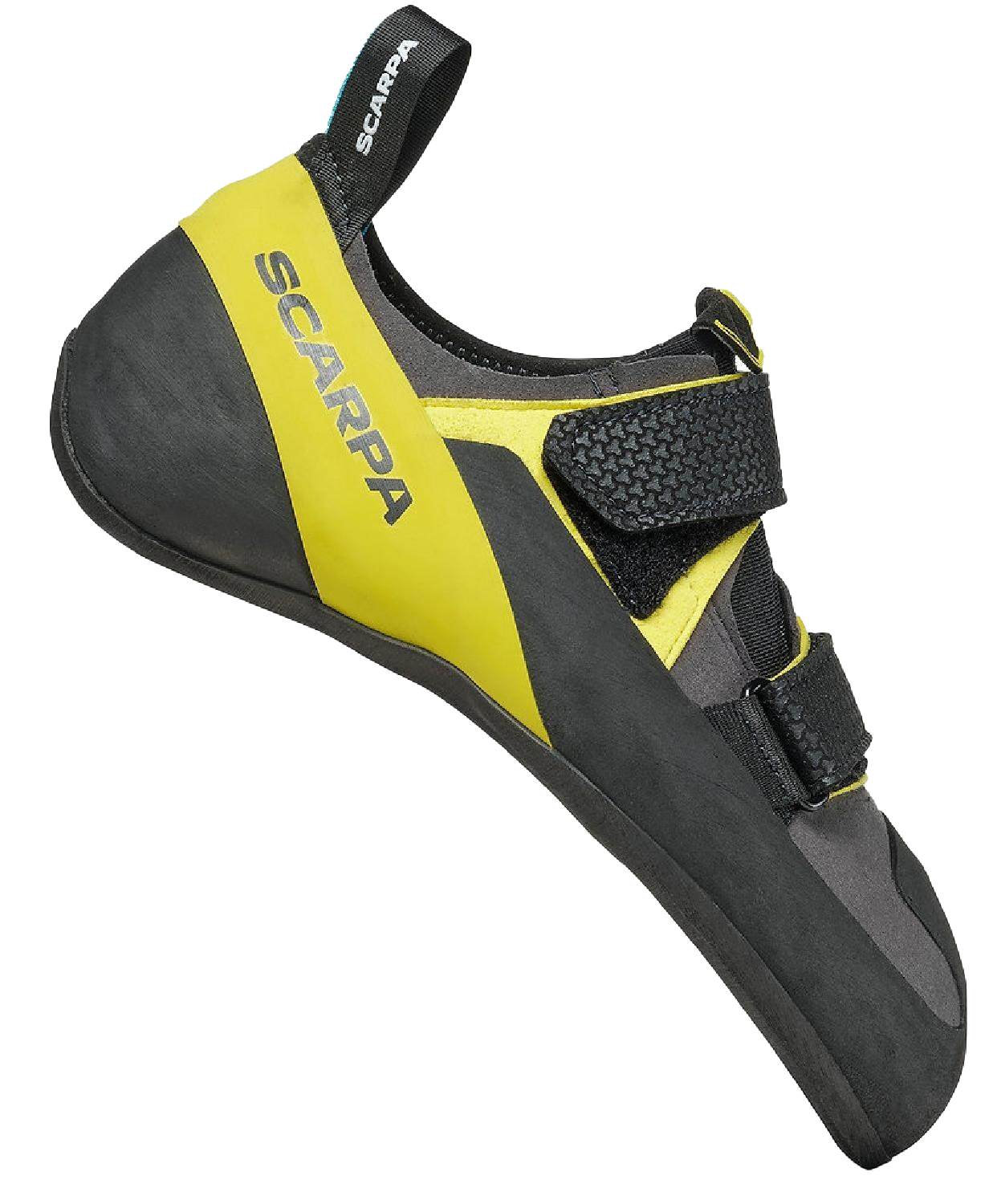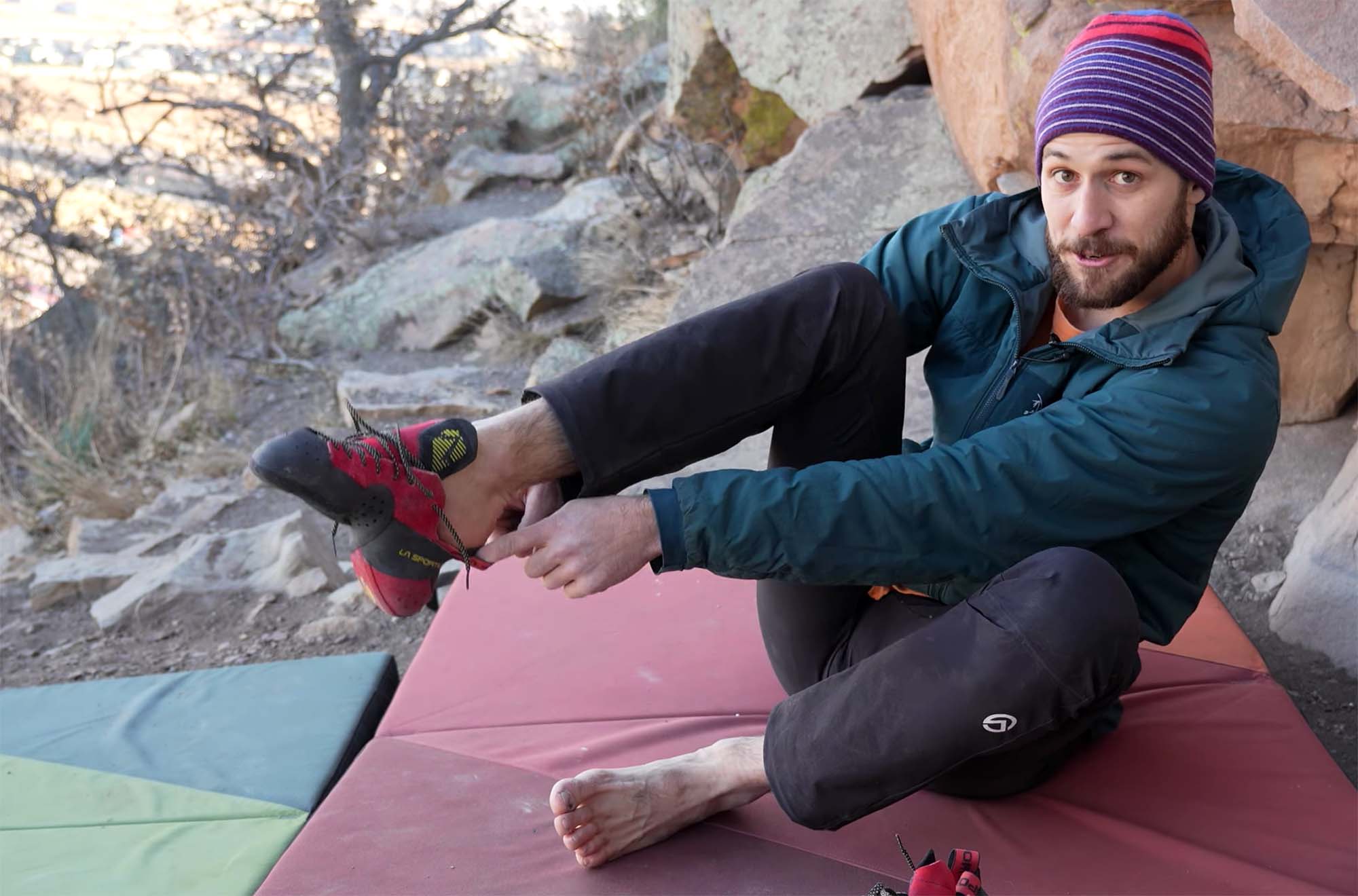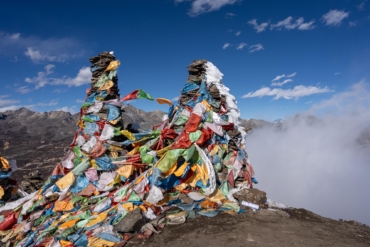SCARPA has a deep bench of rock shoes for climbers who have moved beyond beginner status. These intermediate-level shoes perform well for everything from gym sessions to multipitch.
The SCARPA Vapor line (lace, Velcro, slipper), the Quantic and Quantix SF, and the Veloce lace and Velcro are popular shoes within this niche.
The revamped Arpia V is also a capable contender in this intermediate and practical category. It is a slightly downturned, lightly asymmetrical, dual-Velcro-strap reimagination of the original Arpia, which came out 5 years ago.
With a full-length — versus split — -outsole and midsole, the Arpia V stiffened things up. This made it a more supportive, edging-friendly boot and it came up higher over the foot. It’s simply a bigger, more built-up boot with the attendant pros and cons.
For this review, I tested the SCARPA Arpia V for 3 months. I climbed in them during training sessions at various local gyms in Boulder. And they boosted me up cracks and faces at various crags in the Front Range of Colorado.
In short: The Arpia V is a highly adjustable performance all-arounder with notable support but enough sensitivity, especially after break-in, to build good footwork habits on all but the steepest terrain. SCARPA caters the regular version to wide feet but offers a low-volume version. And the MSRP of $169 won’t break the bank.
- Upper material: Soft touch microfiber (synthetic leather)
- Midsole: 1.4mm Dynamic Flexan midsole
- Outsole: 3.5mm Vibram XS Grip 2
- Closure: Dual Velcro straps
Pros
- Wide, forgiving fit pairs with effective closure for broad sizing options
- Stable, supportive edging
- Precise, “bitey,” lightly sensitive toe good for micro-holds, especially on vert
- Well-built: solid value and will take multiple resoles
Cons
- Full-length sole make for “clunky” grabbing on über-steeps
- Minimalist heel and toe-scum patch lighten shoe up but are squirrely for highly gymnastic bouldering
The SCARPA Arpia V Spec Sheet
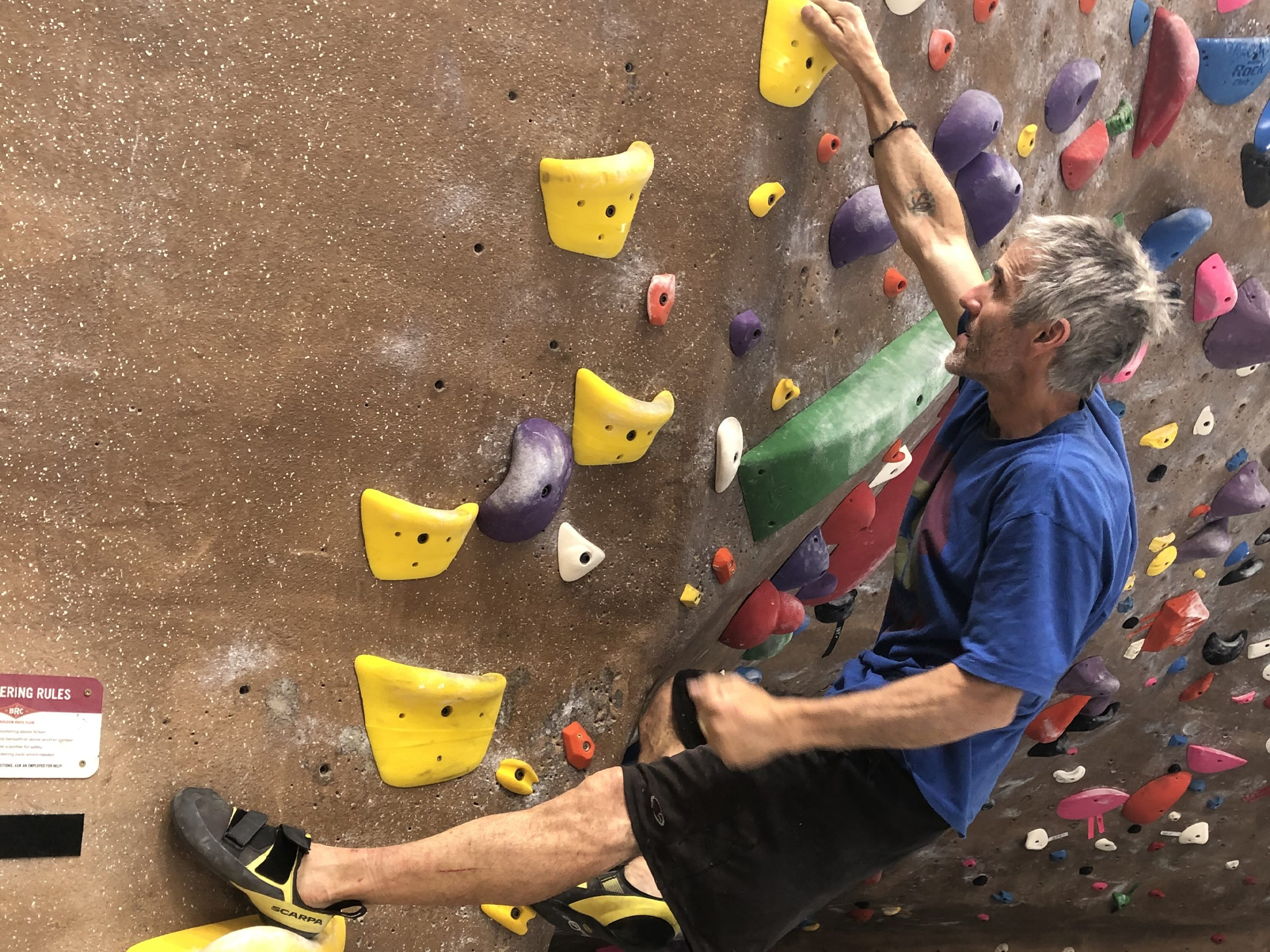
The Original Arpia
The original Arpia came out in 2019. Like the Arpia V, SCARPA bills it as a performance all-arounder but not a top-flight performance shoe. The Italian brand also priced it accordingly, at well below $200.
This first version had a half-length 3.5mm XS Grip 2 sole — Vibram’s softest, stickiest compound — and a 1.5mm midsole. SCARPA used a single-strap, dual-eyelet closure (the Wave Strap closure) to lock it all down.
The Arpia was a semi-stiff, semi-asymmetrical, semi-downturned, low-profile, sensitive shoe. SCARPA bridged the gap between a flat-lasted shoe and a performance fit for climbers pushing up through the grades.
The Main Changes for the Arpia V
Beyond the new color scheme, the big changes to the Arpia V are not quite obvious. It’s slightly more built up over the foot and up the ankle, with greater vertical rise. It now has a full-length XS Grip 2 outsole.
The midsole is the bendier 1.4 mm Dynamic Flexan sole, which imparts fore-to-aft flex to offset the full-length outsole. And the closure has changed to thick, opposing dual Velcro straps. It has generous lateral room in the “tack-down” area to adjust fit.
The uppers are still synthetic microfiber, and the footbed is now microfiber, not leather. SCARPA kept stretch elastic in the tongue area. The Arpia V also has a small, gilled toe-scumming patch and a soft, minimalist heel.
The outsole tapers to a ridged “mohawk” to form this heel. You don’t get a lot of “high performance” bells and whistles, i.e., major rubber coverage, for high-end bouldering. But in the gym on cave boulders and on gneiss at angles up to horizontal, I never slipped out of the basic hooks and scums the shoe is meant for.
The manufacturer’s stated weight for a pair of size 40.5s is 17.2 ounces. On my little home scale, my size 41s weighed 18.0 ounces.
SCARPA Arpia V Fit

Although I’ve always appreciated SCARPA’s commitment to performance all-arounders, some of its stiffer, pointier offerings (Vapor lace and Velcro, Quantix SF) just didn’t fit my wide, high-volume feet.
There hasn’t been enough give even after break-in, and annoying forefoot pinching offset their supposed aptitude for long-term wear. I’d be ripping them off at the anchors, like my aggressive shoes. Out of the box, however, the softer, wider, friendlier Arpia V slid on readily.
Perhaps it’s because the Arpia V’s toebox is much more rounded and visibly wider than the Vapor’s or Quantix SF’s toebox, which let my toes sit more neutrally. Or perhaps it’s the supple uppers, plus the elastic tongue and the gills in the scumming patch, which let the shoe spread out laterally.
Regardless, the break-in was quick. A night or two on the couch, and then straight to the gym auto-belay. I wore them up to four or five pitches in a row without taking them off, thanks to the forgiving last and soft microfiber interior lining.
The new dual-strap closure was effective. The straps are beefy and stayed closed. There’s lots of back-and-forth strap play, and I could adjust the closure angle on the tack-down area. When I wanted a tighter fit for harder climbs, I could get it, with no dead space, leading me to believe more average feet would do well with the Arpia V’s last as well. (There’s also a low-volume version.)
SCARPA Arpia V Performance
Sensitivity and Edging
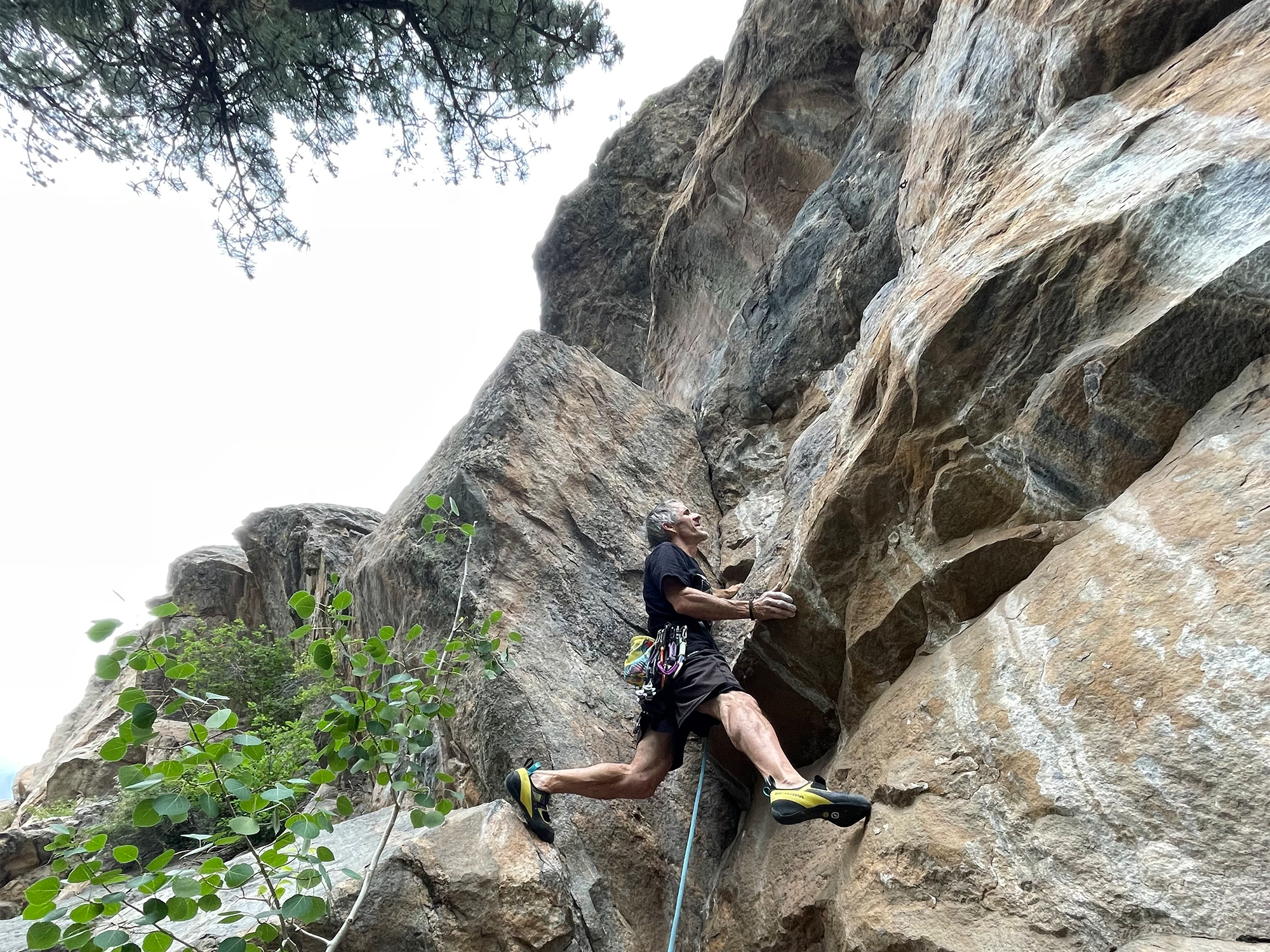
The Arpia V is not — nor is it meant to be — hyper-sensitive. Even with soft XS Grip 2 rubber, the full-length sole rendered a supportive shoe, and as we all know, you don’t get sensitivity with support. Yet neither would I consider them hyper-stiff, like the Boostic or Vapor; just semi-stiff — meaning there was still an appropriate level of feedback.
On small “outie” holds like quartz crystals, and “innie” holds like dimples in sandstone, the Arpia V was remarkably powerful. It was excellent at biting into tiny holds and at front pointing, even with the more rounded toebox.
It was a solid edging shoe with the support you want in an all-arounder to avoid calf fatigue. I found this out on long granite and gneiss pitches on Colorado’s Front Range.
The shoe is downturned and asymmetrical enough to go from relatively steep — up to 30 degrees overhanging — to vertical on the same pitch. I used them repeatedly in the Flatirons, Colo.
On the 5.12 God’s Kingdom on Earth, which has that exact angle change, I could toe in as needed on the overhanging section. Then I edged comfortably on smaller footholds on the vertical headwall, unweighting my cramping forearms.
Heel Hooking, Toe Hooking, and Jamming
This shoe is not a double-digit bouldering shoe with a high-tech, multilayered heel or rubber coating the toe for the modern “feet as hands” style. Instead, it has what I’d call 1990s-level hooking and scumming support. The SCARPA Arpia V had passable glom for gymnastic climbs up to around V7/5.13-.
The heel is basic but ingenious in configuration. The outsole wraps over the heel cup and tapers to form a slightly peaked rib. I dug how light this minimalist heel felt. It was agile for gym bouldering, especially on larger holds like volumes, where it would deform into the pores.
And on gneiss, on a 5.12 whose crux comes turning a body-length roof, the stiff Arpia V fluidly locked into a heel-toe cam in a horizontal crack. Plus, it was easy to release without too many moving parts to hang up on the rock.
SCARPA’s soft M50 rubber makes up the toe-scumming patch and rand. While the toe patch is small, I could get it to catch on larger spikes, tongues, and lips. Again, there was just enough there to get the job done. And I found the Arpia to be stable and reliable in cracks up to fist size, with its semi-high-top cut giving good foot protection.
Smearing and Grabbing
Despite the sticky XS Grip 2, smearing was not the Arpia V’s forte. This was especially true on plastic, where its stiffness made it fine for techy routes and extruded jibs but a little too slippery for volumes. I experienced sudden smearing slippage (the dreaded “SSS”), especially while bouldering.
The full-length outsole also prevented the shoe from bending profoundly for effective grabbing — toeing down and into a hold to suction the hips into the wall. So, on gym cave boulders, I’d often revert to classic frontal edging, climbing frog-like with my hips square to keep my body parallel to the wall.
Honestly, however, this was fine, and the Arpia’s precision helped lock me in. I’d often select a smaller but sharper jib to stand on versus a big, smeary hold. It was just a different technique, an old-school callback to the 1980s and early 1990s when we edged out steeps because there weren’t any soft, downturned shoes yet!
Final Notes on Performance
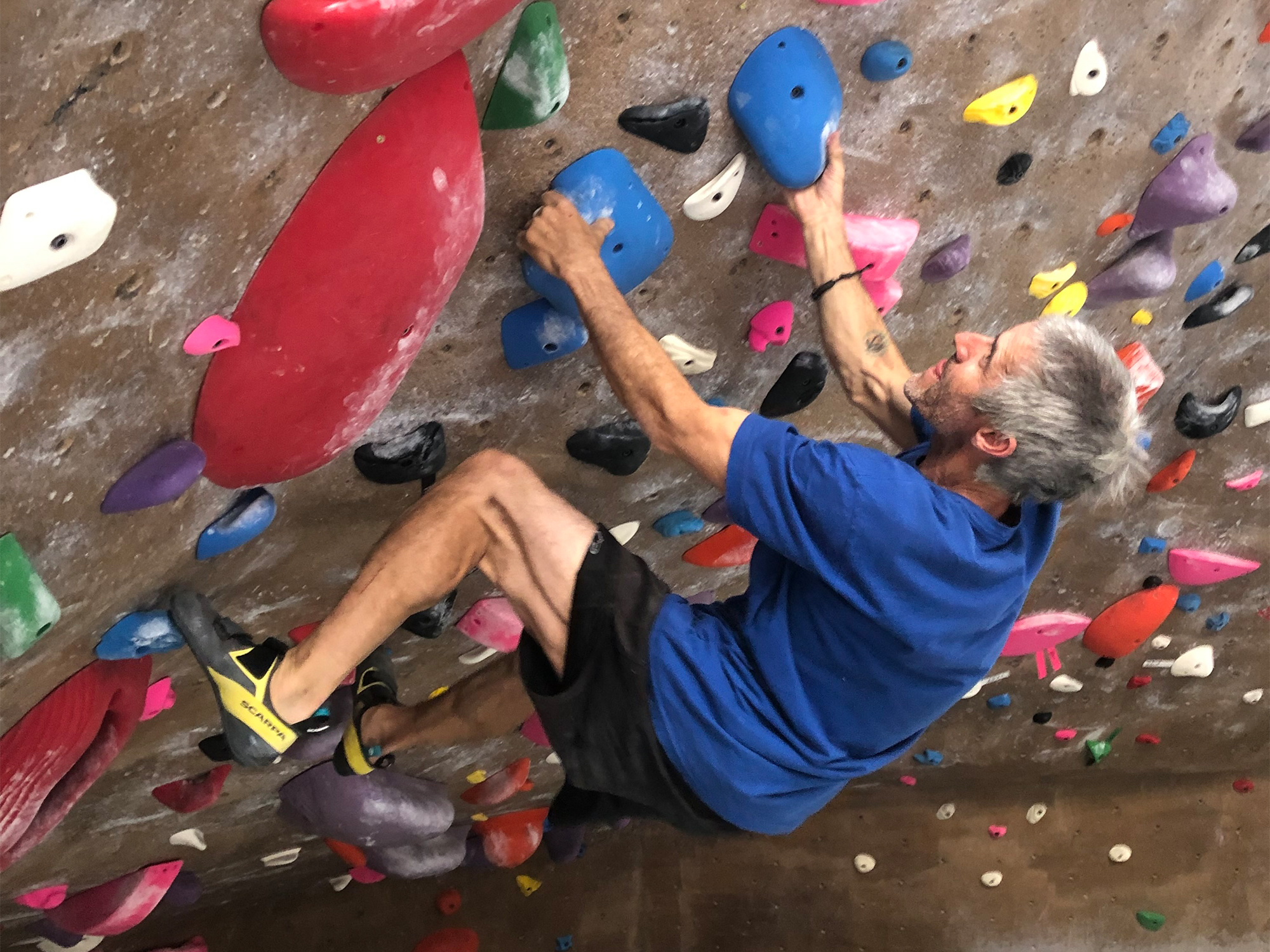
I think the best way to test gear is to evaluate it based on its intended use rather than against competitors.
So, per SCARPA, “The Arpia V is a versatile shoe that can be sized tightly for performance yet remains incredibly comfortable.” And, “The slightly downturned and slightly asymmetrical shape offers an immediate and natural fit, well suited for both indoor and outdoor climbing.”
I’d say that SCARPA succeeded on these counts. The fit was natural, intuitive, and easily adjustable. And on the terrain the shoe is designed for, I got optimum performance, climbing as hard as V7 and thinnish 5.13- face routes.
I thought it was a good shoe for learning precision footwork while also enjoying support as you move from 5.10 and V2 upward.
These were great all-around shoes. I’m sure if you took a time machine 30 years back and handed them to a top climber of the day, they’d have been ecstatic to have such a precise, versatile shoe. And surely would have sent one of the era’s thin, technical 5.14s in them.
Conclusions on the SCARPA Arpia V
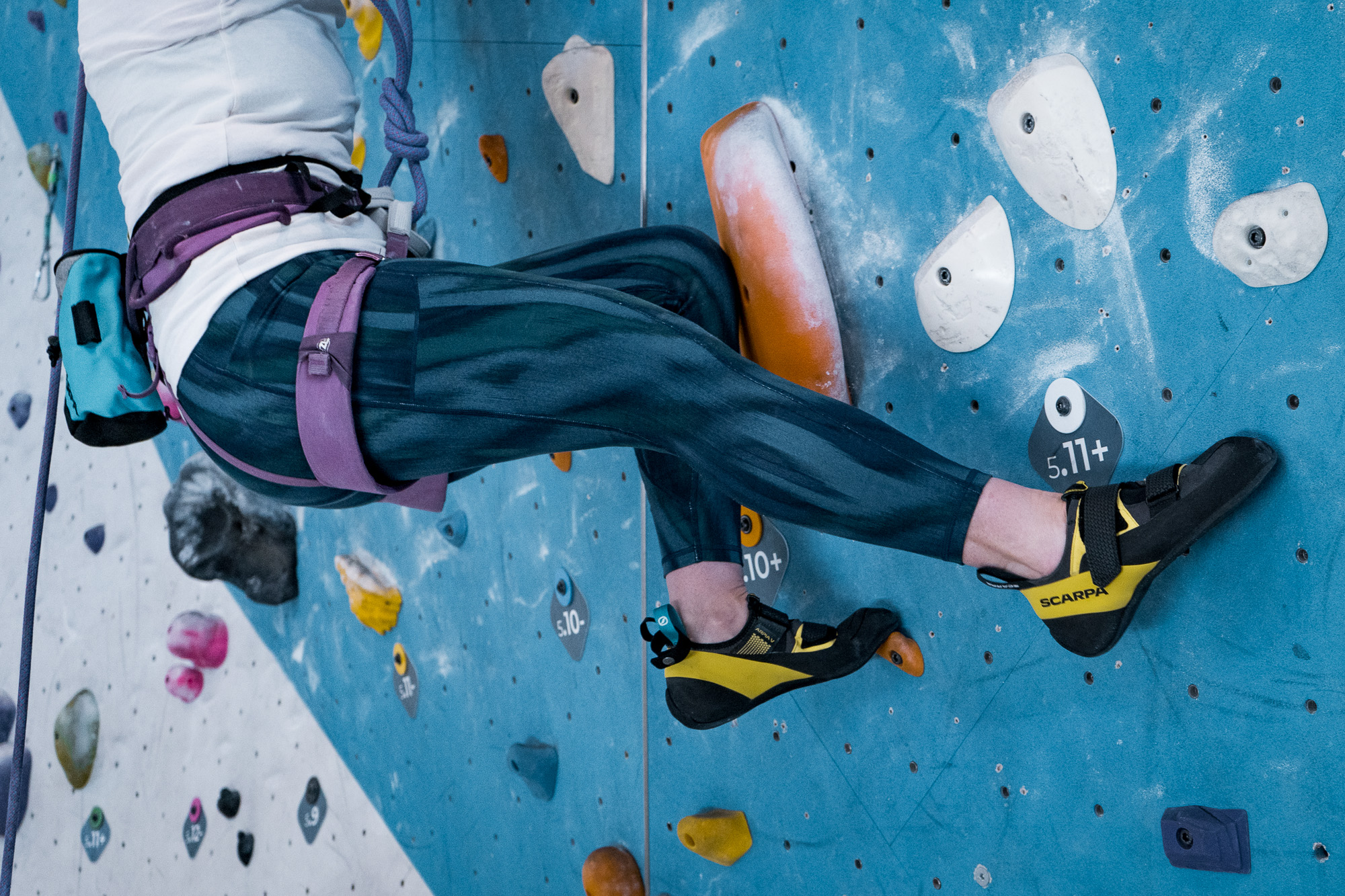
For climbers who have graduated from their beginner, price-point, flat-lasted shoes, and who prefer vert to gently overhanging terrain and a footwork style based more on edging than smearing, the Arpia V is a perfect kick. It’s a sleek, fully realized, light-on-the-foot performance all-arounder that does everything quite well—like 6s to 8s out of 10—except for smearing, and even then, I’d give it a solid 5. And it’s well under $200.
The SCARPA Arpia V was precise and supportive, but it won’t do all the work of standing on small holds for you. The shoe felt like it would grow with you, teaching you to hone in on foothold subtleties and helping strengthen your fine foot and toe muscles as the last softens and you become more of an active participant in your technique.
I’d say this shoe is more of a sport and trad shoe than a bouldering shoe, but it’s still plenty comfy for long-term wear and became my companion on many gym bouldering sessions, especially while warming up or doing circuits.

